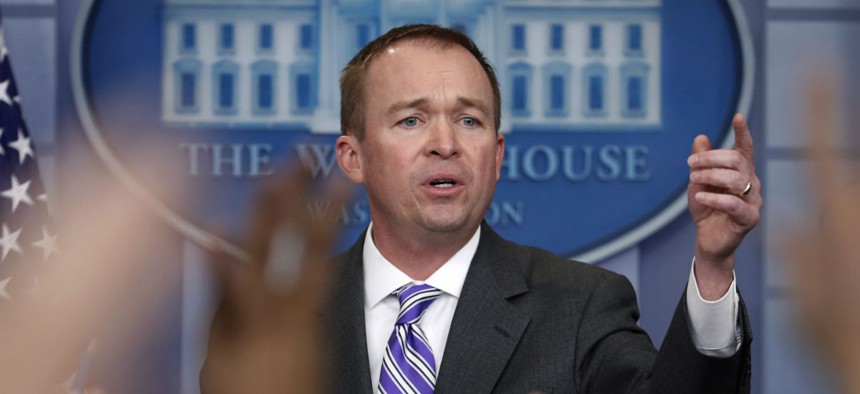
OMB Director Mick Mulvaney speaks to reporters Monday. Lawmakers will have a hard time enacting the cuts proposed by Mulvaney and Trump, observer predicts. Manuel Balce Ceneta/AP
Trump’s Budget Cuts Could Lead to Federal Employee Layoffs, Furloughs
Americans would also likely feel the impacts of service cuts or delays.
In March 2013, the Obama administration ordered a sequestration of $80.5 billion from federal agencies’ budgets. The cuts, as required in the 2011 Budget Control Act, caused immediate chaos across government, forcing agency leaders to implement emergency plans that in some cases sent employees home for several days without pay.
Those cuts were split evenly between defense and non-defense spending, with domestic discretionary funding cut about 5 percent, or about $26 billion. Agencies implemented furlough plans (most of which were eventually scaled back from initial estimates) and hiring freezes, cut services to taxpayers, and delayed planned contracts and investments.
Budget deals in late 2013 and 2015 staved off additional sequesters, as lawmakers from both parties negotiated offsets to raise both defense and non-defense spending caps. In fiscal 2018, however, the initial caps will be reinstated. On top of those restrictions, President Trump will propose an additional $54 billion in cuts to non-defense discretionary spending -- more than double what domestic agencies faced in 2013. The reductions, if implemented, are not expected to be felt evenly across government, with some agencies -- such as the State Department and the Environmental Protection Agency -- likely to absorb deeper cuts.
Still, an Office of Management and Budget official said Monday nearly every federal agency will be forced to slash its spending, requiring them to once again scramble to find significant savings in a condensed timeframe.
“It would require drastic layoffs that would be very hard to do very quickly,” said Alice Rivlin, former OMB director in the Clinton administration.
She added that the spending caps in place since 2013 have forced agencies to trim much of their fat, meaning further reductions of the scope Trump has proposed would require cuts to key services.
“Most domestic discretionary spending has been cut far already,” said Rivlin, now a senior fellow at the Brookings Institution. “It would be hard, without a huge public outcry, to get it done within a year.”
J. David Cox, president of the American Federation of Government Employees, expressed a similar view.
“Many of the federal agencies that would be targeted by these budget cuts already have been cut to the bone this decade as a result of harmful austerity policies,” Cox said. “Americans see firsthand the result of these budget cuts when they have to wait in longer lines to visit a Social Security office or go through airport security screening.” He added the cuts could force agencies to cut the size of their workforces, with dubious avenues for real savings if work is ultimately contracted out. EPA is reportedly already planning to cut 3,000 -- or 20 percent -- of its employees.
Rivlin expressed doubt the cuts will actually go into place as outlined, noting likely pushback both within federal agencies and from congressional appropriators. Trump’s plans have already received criticism from lawmakers, both from Republicans who say the $54 billion increase to defense spending is insufficient and Democrats who said the domestic cuts would harm the economy and surrender American leadership. Actual outlays in fiscal 2018 would not come close to equaling the proposed spending increases and cuts, as agencies would need time to implement the policies they come up with for their adjusted funding levels.
At the agency level, career employees are likely throughout what is known as the “passback” phase of the budgeting process to spell out to OMB estimates of what would happen if the proposed cuts were implemented. The Education Department, for example, might point out how many students would lose Pell grants if student aid were cut, while the Centers for Disease Control and Prevention might estimate the increased chance it would not catch an epidemic before it spread, Rivlin said. Typically, she explained, agency leaders who fail to convince the OMB director would have one last chance to lobby for any spending they deem absolutely necessary to the president himself before the budget is finalized.
The normal budget process, Rivlin said, may be “short circuiting” as OMB Director Mick Mulvaney was just sworn in last week.
Marc Goldwein, senior vice president and senior policy director at the Committee for a Responsible Federal Budget, said the administration must decide if the cuts will eliminate agencies and programs entirely or if the government will just do less of everything it currently does. He predicted agencies would forgo needed investments, such as training and new buildings, which would amount to a “spending deferral, not a cut.”
Congress, he said, could adjust the spending caps upward for defense and downward for non-defense, though it would break from previous budget deals in which both caps were raised in favor of cuts to mandatory spending. This represents the first time in which Republicans hold a unified government, though revisions to spending restrictions would require at least some Democrats in the Senate to get on board. Goldwein predicted lawmakers would have a difficult time meeting the cuts outlined by Trump and Mulvaney.
“Back in 2013 when the appropriators tried to spend within sequester levels, they couldn’t do that,” he said. “This is $54 billion below that.”







